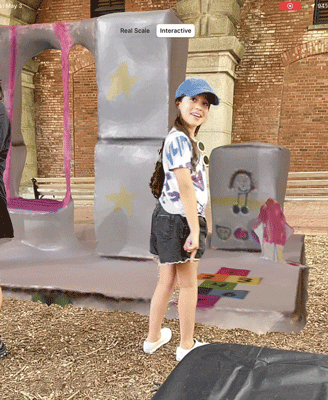Augmented Reality is Building Civic Courage in New York City’s Newest Public Space
At the Manhattan foot of the Brooklyn Bridge, where 19,000 people walk every day, the journey used to end in a fenced-off parking lot. Not anymore.
.png)
In the heart of New York City, a neglected parcel beneath the Brooklyn Bridge is undergoing a remarkable transformation. The former Brooklyn Banks skate spot, long abandoned and inaccessible, is being reborn as Gotham Park. A new grassroots movement is turning a forgotten underpass into a new kind of civic space:
Gotham park sits at the intersection of Chinatown and Lower Manhattan, two of the city’s densest neighborhoods, and is adjacent to a National Historic Landmark. The area is home to a vibrant mix of seniors, students, and families, but has been historically underserved by public investment. But it’s suffered for decades from poor connectivity, underused infrastructure, and a lack of adequate public space.
This is more than a restoration project; it’s a reimagining of how urban spaces can be created. Through grassroots organizing, community-driven design, and innovative partnerships, the organizers behind the project are setting a new standard for civic development. At its core is a simple yet powerful idea: “A park for our communities, by our communities.” This guiding principle shapes every aspect from the project from initial planning to programming and outreach. It was this community-first approach that made Gotham Park team up with inCitu, leading to a partnership that would bring new dimensions to community-led design.
Making the Future Visible: inCitu’s Role
inCitu deploys immersive technologies to foster more democratic, creative, and empowered collaboration around urban projects. Our team collaborated with Gotham Park to apply augmented reality (AR) as a civic tool to visualize and co-create urban change.
Youth Co-Design With UA Maker Academy
We started by working with high schoolers from The Urban Assembly Maker Academy, who were already working with Gotham Park through a community design internship. Together with their teacher Melissa Giroux, the students had designed street furniture that could repurpose rainwater from the Brooklyn Bridge.
We helped transform their physical models into AR experiences, bringing their concepts to life at Gotham’s annual block party, where neighbors could see and interact with student work at full scale. In addition to showcasing the students’ work, this collaboration proved that young people’s visions matter, and that immersive tech can give them a louder, clearer voice in shaping their city.
Empowering Younger Creators With PS 150
We also partnered with even younger designers from PS 150 and the Center for Architecture’s youth education team. Kindergarteners dreamed up everything from splash pools to swing sets, which we scanned and rendered in AR to show during public events. Watching these 5-year-olds beam with pride as their tiny paper ideas appeared as towering 3D structures in the space was a vivid reminder of what’s possible when you treat every resident—even the smallest—as a potential citymaker.
Making Planning Accessible and Fun
For a number of public events, inCitu set up interactive AR stations where residents could create and visualize their own ideas for the park. Neighbors of all ages used simple building blocks, MagnaTiles, Legos, and even folded paper to build features they wanted to see in the park. We scanned these models and placed them in digital space throughout the site, allowing the community to go out and see their neighbors’ visions for the park, at full scale. These playful activities turned traditional consultation into interactive celebration, and made what is normally an abstract planning process feel tangible, intuitive, and fun.

The Case for Immersive Co-Design
Our work at Gotham Park is part of a broader experiment in expanding the role of AR from passive viewing to active civic participation. By making future possibilities visible and tangible, AR encourages deeper community involvement. Immersive tools can accelerate public processes, increase trust, and create richer conversations that move beyond yes-or-no binaries.
Our theory of change:
→ People engage more deeply when they can see and shape future possibilities at human scale. Human scale means making abstract planning concepts accessible and understandable.
→ Communities grow stronger when individuals gain the confidence and the tools to contribute—not just ideas, but design visions.
→ Cities improve when more voices are empowered to take part in their transformation—not as feedback providers, but as co-creators.
Looking Ahead
Gotham Park’s story is still unfolding, but it’s already proving that reimagining forgotten infrastructure can unlock more than just space. It can unlock civic courage. It is testament to what’s possible when communities are given the tools and the opportunity to shape their own environment. As cities worldwide grapple with issues of urban change and community engagement, projects like this offer valuable lessons and inspiration.
At inCitu, we’re excited to keep building tools that support this kind of spatial empowerment. Whether it’s a youth-led redesign of a corner plaza or a neighborhood effort to rethink schoolyards, we believe every community deserves a seat, and a stake, in the design of the places they call home.
Is there a community, school, or project in your life that could benefit from immersive co-design? We’d love to hear about it. Drop us a note in the comments or reach out directly. And be sure to follow @GothamPark to keep up with this transformative work.


.png)